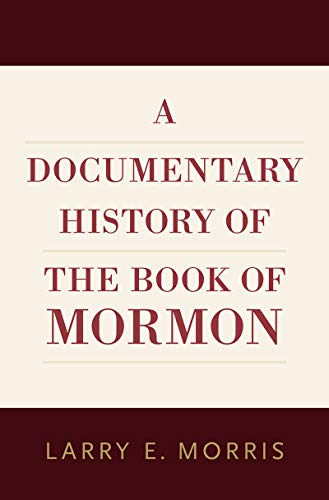
Larry E. Morris has written books on the exploration of the American West as well as several papers on Oliver Cowdery and the other witnesses of the Book of Mormon. He also served as an editor of the Joseph Smith Papers Project. He gave a presentation at the 2007 FAIR Conference and he will be speaking at the upcoming FairMormon Conference on August 8.
In this book, Morris brings together for the first time a single volume collection of primary source documents pertaining to the production of the Book of Mormon. The documents are annotated and introductory essays are included that give us the context. He draws on the work of authors such as Richard Bushman, Terryl Givens, D. Michael Quinn, Fawn Brodie, Dan Vogel, Richard Van Wagoner, Grant Palmer, and Dale Morgan, where applicable, while not hesitating to also provide critiques on their work as necessary.
The book is divided into eleven sections, with each section covering specific events, such as the appearance of Moroni, the receipt of the plates, various phases of the translation, the witnesses, and the publication of the Book of Mormon. A very useful chronology is given from September 21, 1823, when Moroni first appeared to Joseph Smith, up to April 6, 1830, when the church was officially organized.
As an example of what is included in the section introductions, here are some details that are not well known about the translation, from chapter 4:
In 1828, when Harris acted as Joseph’s scribe, the commandment was still in force that no one beside Joseph be allowed to see the plates, Urim and Thummim, or other objects preserved in Moroni’s cache. A curtain or screen was therefore used to separate the two men, a detail first mentioned in The Reflector, a Palmyra newspaper, on March 29, 1831. …Once Joseph switched from the spectacles to the seer stone, a screen was no longer necessary, which Harris made quite evident in his recollection of how he once tested the translation process by replacing Joseph’s stone with another. [page 251]
There are separate sections covering the three witnesses and the eight witnesses. Regarding what has been said about Martin Harris, it is pointed out that “The ironic thing is, most critics – both nineteenth-century and modern – who interpret Harris’s mention of ‘spiritual eyes’ to mean he likely imagined the plates are the same people who do not believe in heavenly visions or visitations in the first place and are unfazed by Whitmer’s unequivocal account of seeing the plates with physical eyes.” [page 371] In the section on the eight witnesses, he spends several pages discussing problems with the work of Brodie, Morgan, Van Wagoner, and Palmer.
One of the documents gives an interesting second-hand description of the breastplate, from a letter:
I have not heard but one sermon since we have been in this place and that by Hyrum Smith. As he was moving to Missouri he tarried with us a little while. His discourse was beautiful. We were talking about the Book of Mormon, [of] which he is one of the witnesses. He said he had but two hands and two eyes. he said he had seen the plates with his eyes and handled them with his hands and he saw a breast plate and he told how it was made. It was fixed for the breast of a man with a hole in [the] stomach and two pieces upon each side with a hole through them to put in a string to tie it on, but that was not so good gold as the plates for that was pure. Why I write this is because they dispute the Book so much. [page 443]
This book is important not just because it’s a one-volume collection of documents pertaining to the Book of Mormon, but also because it points out the strengths and weaknesses of published interpretations of the documents. Morris writes with an engaging style that makes it a pleasure to read. And he has selected a very interesting collection of documents. Anyone wanting to learn more about the history of the Book of Mormon should definitely consider this book.
The post Book Review: A Documentary History of The Book of Mormon appeared first on FairMormon.
Continue reading at the original source →



